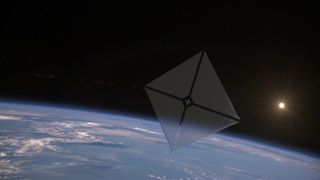Rocket Lab to launch NASA's new solar sail technology no earlier than April 24
"Seven meters of the deployable booms can roll up into a shape that fits in your hand."

A NASA solar sail mission meant to test new space travel materials in Earth's orbit is scheduled to lift off no sooner than April 24, the space agency announced on Thursday (April 11).
Named the Advanced Composite Solar Sail System, or ACS3, the mission's primary goal is to test the deployment of solar sails using new composite booms, which are tube-shaped materials meant to unfurl and hold four very thin triangular sheets tautly. These sheets, together, form a kite-like solar sail. The ACS3 booms pull the solar sail into the size of a small apartment from a microwave-sized satellite in under 30 minutes, and are stiffer and lighter from previous technology, NASA said in a statement. The spacecraft is scheduled to launch onboard Rocket Lab's Electron rocket from the company's launch site in Māhia, New Zealand.
Solar sails, which propel payloads by harnessing sunlight the same way sailboats use wind, have gathered momentum in recent years as affordable alternatives for conventional, chemically propelled rockets. When particles of light called photons strike a solar sail, they transfer their momentum to that sail. Although slight, such subtle pushes are consistent and can help spacecraft cruise through space, even allowing them to accelerate over time to speeds achievable with conventional rockets. Astrobiologists deem solar sails worthy in the search for alien life on Jupiter’s moon Europa and Saturn’s moon Enceladus, two ice-covered worlds thought to harbor conditions friendly toward life as we know it in their hidden, subsurface oceans.
Related: LightSail 2 spacecraft ends its solar-sailing mission in a blaze of glory
Although previous missions like the Planetary Society's notable LightSail 2 have already demonstrated that small spacecraft can indeed utilize solar sails to travel millions of miles and change orbits as needed, those missions used metal booms, which are heavy and could unpredictably morph thanks to sharp temperature swings known to occur in space. Meanwhile, ACS3 is four times bigger than LightSail and uses lighter booms made of carbon fiber reinforced polymer, or CFRP, which are strong enough to hold the solar sail tautly while flexible enough to fold compactly for launch, NASA said.
"Seven meters of the deployable booms can roll up into a shape that fits in your hand," Alan Rhodes, the mission's lead systems engineer at NASA's Ames Research Center in California, said in the statement. "The hope is that the new technologies verified on this spacecraft will inspire others to use them in ways we haven't even considered."
Once the spacecraft reaches its predetermined orbit of 600 miles (1,000 kilometers) above Earth's surface, it will begin the 25-minute process of unrolling the composite booms, which span the diagonals of the sail. Assuming all goes to plan, the mission would also test changing the spacecraft's orbit via the solar sail, a maneuver that could offer useful data for future missions, NASA said.
Get the Space.com Newsletter
Breaking space news, the latest updates on rocket launches, skywatching events and more!
Upon complete deployment, the solar sail will measure about 860 square feet (80 square meters), which is roughly as wide as six standard parking spots. The space agency predicts the solar sail will be large enough that its shiny reflective surface will sparkle above our planet as brightly as Sirius does, the brightest star in the night sky.
Join our Space Forums to keep talking space on the latest missions, night sky and more! And if you have a news tip, correction or comment, let us know at: community@space.com.

Sharmila Kuthunur is a Seattle-based science journalist covering astronomy, astrophysics and space exploration. Follow her on X @skuthunur.
